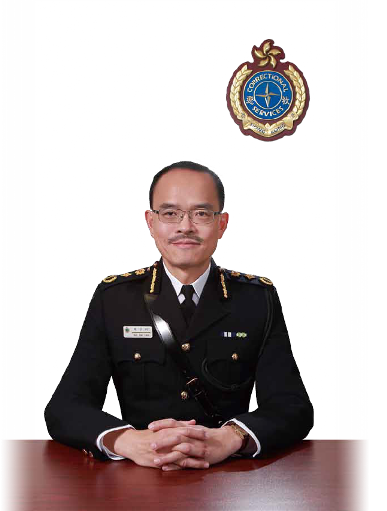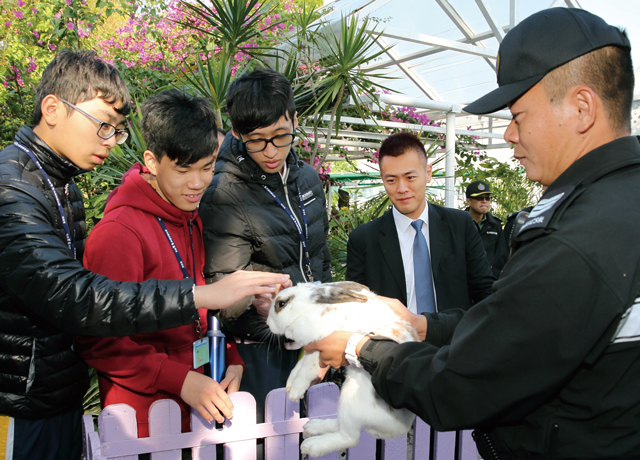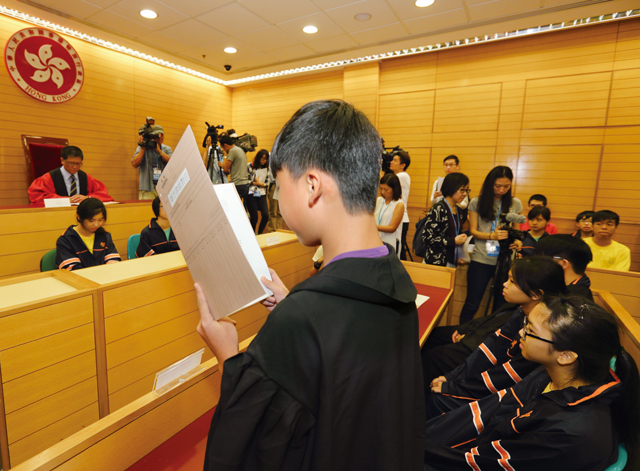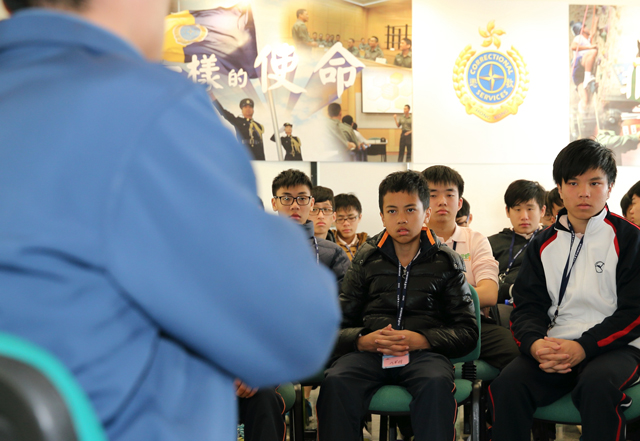Commissioner's Foreword
 The Correctional Services Department (CSD) has persistently dedicated ourselves to providing safe custody and appropriate rehabilitation programmes for the well-being of society at large. The objectives are to protect public safety and reduce crime. In addition, we continue to collaborate with various stakeholders to strengthen community education. Such efforts not only help rehabilitated persons reintegrate into society, but also contribute to the prevention of crime, particularly among young people.
The Correctional Services Department (CSD) has persistently dedicated ourselves to providing safe custody and appropriate rehabilitation programmes for the well-being of society at large. The objectives are to protect public safety and reduce crime. In addition, we continue to collaborate with various stakeholders to strengthen community education. Such efforts not only help rehabilitated persons reintegrate into society, but also contribute to the prevention of crime, particularly among young people.
In 2015, the average daily penal population at correctional facilities was 8 413 persons, representing a slight decrease of 4% from 8 797 persons in 2014, and the average occupancy rate was 76%. In the same year, 147 high security risk persons in custody (PICs) were convicted and newly admitted into our correctional facilities, representing a substantial increase of 39% from 106 persons in 2014.
As at December 31, 2015, more than ten thousand persons were under the management of CSD, including 8 438 PICs and 1 991 rehabilitated persons under supervision after release. Of these 8 438 PICs, 70% were local; 12% were from the Mainland, Taiwan and Macau; and the proportion of PICs from other countries increased from 15% in 2014 to 18% in 2015, amounting to 1 525 persons from 65 countries.
There has been no successful escape case over the past eight years. On the other hand, there were 3 671 disciplinary charges last year, an increase of 79 charges (2%) compared with 3 592 charges in the previous year. As to acts of violence, a total of 522 cases, mainly involving fighting among PICs and assaults, were recorded in 2015, representing a decrease of 45 cases (8%) from the previous year. Among them, there were 15 cases (one case less than the previous year) involving correctional officers being assaulted during their course of duty. Notwithstanding the decrease, the number of staff injured on duty increased from 18 persons to 29 persons. Such increase reflects the challenges and pressures encountered by correctional officers. CSD will continue to enforce the law vigorously to combat incidents of indiscipline.
Although our correctional work has been effective and the custodial environment is safe and in good order, the associated security risks have increased, including a growing number of newly admitted Category A PICs, the number of medical escort duties remaining high and an increase in the number of disciplinary offences committed by PICs. To tackle emergencies within and outside institutions and to step up such tasks as high-risk escort duties, we will set up Regional Response Teams under the Escort and Support Group with a view to providing more effective, prompt and tactical support at regional level.
We continue to carry out appropriate measures to improve comparatively old facilities. The partial redevelopment of Tai Lam Centre for Women is scheduled for completion by the end of 2016. Between now and 2019, we will enhance the existing closed-circuit television (CCTV) system at Stanley Prison to become a new, digital system. We will also seek funding approval from the Legislative Council to install an electric lock system at Stanley Prison, and enhance the existing CCTV systems at Siu Lam Psychiatric Centre and Pak Sha Wan Correctional Institution to digital systems.
In addition, to strengthen security and prevent the smuggling of dangerous drugs into institutions by concealment inside the human body, CSD introduced four low-radiation X-ray body scanners in the reception centres. The measure successfully deterred such smuggling activities and reduced the number of cases of illegal dangerous drugs being found from 51 in 2014 by 35% to 33 in 2015. Three more scanners will be installed in 2016. By then, a total of seven scanners will have been installed in all reception facilities, replacing most manual rectal searches.
CSD works closely with over 80 non-government organisations (NGOs) to implement diversified and appropriate rehabilitation programmes and initiatives. Our concerted efforts offer opportunities and assistance to PICs by equipping them with useful skills and education as well as building up their self-confidence, so that they can start a new life and reintegrate into society after release.
Young PICs are assisted in receiving education according to progress and potential. They have attained good results, such as attaining Level 5** for the first time under the Hong Kong Diploma of Secondary Education Examination or admitted by local universities. We also provide guidance and assistance to adult PICs who are willing to pursue further studies. To strengthen the employability of PICs, 20 vocational training courses are provided for young PICs and more than 40 market-oriented courses are available for adult PICs who are due for discharge within three to 24 months. In 2015, some 1 400 adult PICs voluntarily enrolled in vocational training courses.
CSD also encourages employers to register as “Caring Employers” and offer job opportunities to rehabilitated persons. In December 2015, we organised a video conferencing job fair again with the Chinese Manufacturers’ Association of Hong Kong and Merchants Support for Rehabilitated Offenders Committee Limited. More than 30 business organisations from 10 trades participated. In mid-2016, we will again organise the Employment Symposium with a tertiary institution to further explore how to facilitate the employment of PICs after release.
In addition, CSD and the Psychology Department of the Chinese University of Hong Kong have jointly completed a project on psychological counselling services for sex offenders and developed the local Risks and Needs Assessment Tools for Sex Offenders. This project is funded by the Hong Kong Jockey Club Charities Trust. The tools became ready for use on February 1, 2016, both in the preparation of psychological reports and programme matching.
Over the years, CSD has reached out to the community to promote rehabilitation work and seek public support for and acceptance of rehabilitated persons. Apart from ongoing publicity and education activities, we organised various large-scale signature programmes in 2015, including district-based publicity activities co-organised with the 18 District Fight Crime Committees, the Thank You NGO Month, the NGO Forum, and the Award Presentation Ceremony for Volunteers of CSD Rehabilitation Volunteer Group.
On community education, CSD focuses on disseminating to students and young people the important messages of leading a law-abiding and drug-free life as well as supporting rehabilitation under the Rehabilitation Pioneer Project. Over 30 000 participants attended various activities in 2015. Since September 2015, we launched a brand-new community education programme, “The Reflective Path”, for students. The programme, held in a mock court and the vacated Ma Hang Prison, enables students to experience the basic process of imprisonment, understand Hong Kong’s criminal justice system and correctional services, and go through the journey of PICs, so that they will reflect on the heavy cost of committing crime and the importance of abiding by the law.
CSD is undergoing a peak period of staff wastage. We conduct recruitment exercises actively to fill vacancies. Although the penal population has slightly decreased, the need for medical escort of PICs to outside clinics or hospitals remained high. On average, CSD staff performed about 39 000 days of such escort duties each year between 2013 and 2015, and this workload has put tremendous pressure on manpower.
CSD is committed to serving the public and maintaining the safety and stability of Hong Kong with dedication and professionalism. We are very grateful for the support of the public and community stakeholders. We will continue to work with all sectors of the community for a safe and inclusive Hong Kong.
YAU Chi-chiu, CSDSM
Commissioner of Correctional Services




